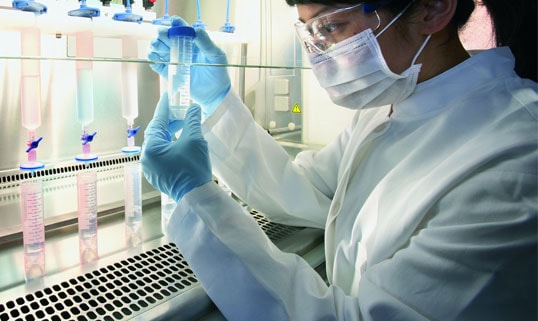Anti-human (ETNL) NIS antibody (affinity purified)
- 100 ul / Standard (REA009-STAN) $ 495
Description: Affinity purified rabbit polyclonal antibody to human (ETNL) NIS
Antigen: Synthetic peptide GHDGGRDQQETNL corresponding to residues 631-643 of the human sodium iodide symporter, hNIS (ref.1).
Detects both the native and denatured forms of human NIS. This antibody recognizes an intracellular C-terminal epitope. This antibody does not detect rhesus, mouse, pig or dog NIS.
Host Species: Rabbit
Isotype: Not applicable. Polyclonal affinity purified antibody.
Concentration: 1.5 mg/mL
Species reactivity: Human
Tested Applications (see references below):
- Flow cytometry (1:500 dilution) Refs: 2,3
- Immunofluorescence (1:500 dilution) Refs: 3,4
- Immunohistochemistry (1:5,000 dilution) Refs: 5,6
- Western Blotting (1:1,000 to 1:5,000 dilution) Refs: 1,5
Selected Product References:
1. Wapnir et al. J Clin Endocrinol Metab. 2003. 88-1880-1888.
2. Li et al. FASEB J 2003. 27: 3229-3238.
3. Paroder et al. 2013. J Cell Sci. 126: 3305-3313
4. Dohan et al. Mol Endocrinol 2006. 20: 1121-1137
5. De la Vieja et al. 2004. J Cell Sci. 117: 677-687
6. De la Vieja et al. 2005. Mol Endocrinol 19: 2847-2858
7. Tazebay et al. 2000. Nat Med. 6: 871-878
All testing were performed by scientists at Imanis Life Sciences.
Immunofluorescence staining for human NIS expression:
HelaH1 cells stably-expressing (left) human NIS or (right) rhesus macaque NIS were fixed, permeabilized and stained with anti-human ETNL NIS antibody (1:500 dilution) followed by an Alexa Fluor 594-conjugated anti-rabbit secondary antibody and Hoechst 33342 to stain nuclei. Cell photos were taken at 200X magnification.

Immunoblotting for human NIS protein:
Total protein (20 ug) from parental HeLaH1 (lane 1), HeLaH1 cells stably-expressing human (lane 2), mouse (lane 3), rhesus macaque (lane 4), pig (lane 5) or dog (lane 6) NIS were subjected to SDS-PAGE and western blot analysis using anti-human ETNL NIS antibody (1:3,000 dilution) and HRP-conjugated anti-rabbit secondary antibody. A 90kDa band of NIS was detected.

Flow cytometry:
(Left panel) parental HelaH1 cells or (right panel) HelaH1 cells stably expressing human NIS linked to enhanced green fluorescent protein (GFP) were fixed, permeabilized, and stained with anti-human ETNL NIS antibody (1:500 dilution) followed by an Alexa Fluor-594 conjugated anti-rabbit secondary antibody. Samples were subjected to flow cytometry analysis.


